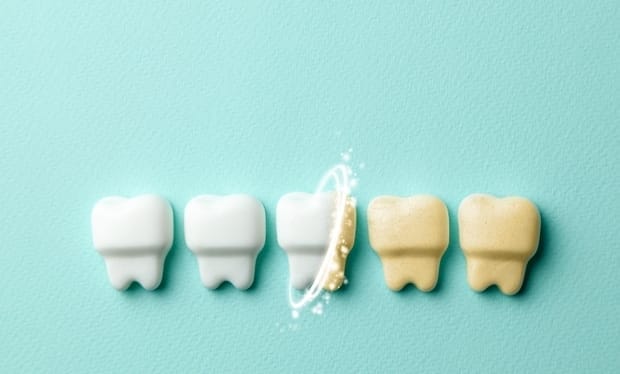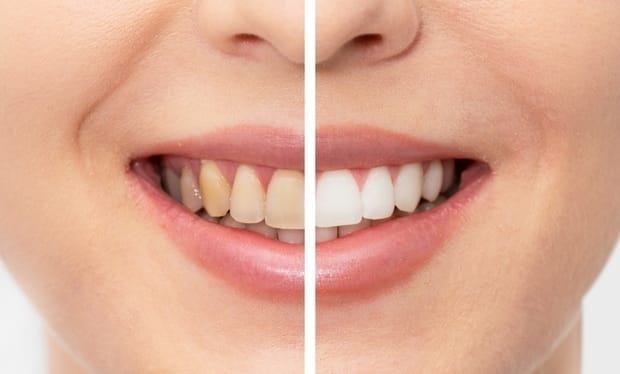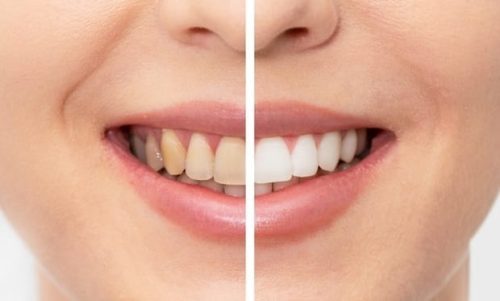Having snow-white teeth is essential for a sincere and big smile. It is normal for tooth color to change over time and if you do not take good care of them, your teeth may lose their brightness. One of the most important reasons for discoloration is the thinning of the enamel layer that protects the teeth over time. There are genetic factors and dietary factors that can also cause discoloration of the teeth.

 4.7
4.7
Would you like to receive information about the operations from Vanity Doctors?
As Vanity, we can give you information about the operation you are considering.
Ask the DoctorIf you are also uncomfortable with the discoloration of your teeth, then let’s examine the methods of preventing tooth yellowing that will eliminate your aesthetic concerns.
What is Tooth Discoloration? What Do Different Tooth Colors Mean?
Tooth discoloration refers to stains and darkening of the teeth. This can be caused by aging, trauma, eating habits, and poor oral hygiene.
Stains can be of different colors. These colors and their causes can be listed as follows:
Yellow stains: They occur when you do not maintain adequate oral hygiene. Another reason is consuming dark-colored foods and drinks.
Brown stains: These stains can be caused by frequent consumption of cigarettes and tobacco products and insufficient dental hygiene. Over time, they can develop into tooth decay.
Purple stains: Usually seen in people who consume too much red wine and neglect their oral health.
Gray stains: This can be caused by dead dental nerves and dental trauma.
White stains: Indicates a high level of fluoride in your teeth.
Black stains: Usually tell us that you have a cavity.

What Are the Most Common Causes of Tooth Discoloration?
The factors that cause tooth discoloration can be listed as follows:
- Dark-colored foods and drinks
- Smoking
- Poor oral hygiene
- Genetics
- Excess fluoride
- Tooth trauma
- Aging
- Certain diseases
- Certain medicines
- Cancer treatment
Some of these causes of discoloration are preventable, but some are inevitable.
Dark-colored foods and drinks: Foods such as coffee, tea, fruit and wine can cause tooth discoloration over time
Smoking: Tobacco and cigarette consumption can have adverse effects on both your overall health and your dental health. Nicotine and other chemicals in cigarettes can erode tooth enamel and cause discoloration over time.
Poor oral hygiene: If you fail to brush and floss regularly, plaque build-up and subsequent discoloration can occur.
Genetic factors: Genetic factors can cause tooth discoloration. Structural defects in the enamel tissue, thinning or increased thickness can also be seen in children
Excess fluoride: It can cause white tooth stains, especially in children with developing bones.
Tooth trauma: Falling and impact on the teeth can cause stains.
Aging: As we age, the enamel becomes thinner and the yellow color of the layer of dentin underneath can become more visible.
Certain diseases: Cancer treatment and antibiotic use can cause stains on teeth.
Types of Tooth Discoloration
For a healthy smile, white and bright teeth have a very significant role. However, tooth discoloration can interfere with this healthy appearance and cause aesthetic concerns. Tooth discoloration may be due to many internal and external causes and may require intervention by the dentist. The causes of tooth discoloration can be explained as follows:
External discoloration
Color changes that affect the outer surface of the tooth. Nutrition, colorful drinks such as tea, coffee and wine that you consume fondly can be given as examples. Acidic foods also prepare the ground for discoloration by eroding tooth enamel.
Internal discoloration
Internal discoloration starts in the inner layers of the tooth. It can be seen in people who use antibiotics, especially in childhood.
Various diseases and aging can also cause thinning of the tooth enamel and discoloration.
Tooth decay can also cause discoloration. Bacteria produce acid when they break down food on teeth that are not brushed properly and have food residues. This leads to weakened enamel, discoloration and, if not prevented, cavities.
How To Get Rid of Yellow Teeth?
If you want to whiten your teeth, there are some methods you can apply at home. It is always advisable to consult your doctor to avoid unwanted conditions such as tooth sensitivity and cavities, no matter how innocent the methods are.
You can try the following methods to get rid of yellow teeth:
- Regular tooth brushing
- Choosing activated charcoal toothpaste
- Reconsider your dietary habits
Brush Your Teeth Regularly
It is imperative to brush your teeth regularly and correctly after meals.

Get a toothbrush that is suitable for your teeth, one that is not too hard and change it regularly. You can choose a reliable toothpaste with whitening properties. These toothpastes can be effective for removing surface stains. In addition, they are soft enough not to abrade the teeth.
Make sure you do enough cleaning by making circular motions while brushing. By carefully brushing the outer and inner parts of the teeth, the back and the parts that meet the gums, you can be protected against the damage caused by bacteria.
Use Activated Charcoal Toothpaste
Activated charcoal is highly absorbent and this can reduce pigmentation on the teeth.
Put the activated charcoal paste on your toothbrush and brush your teeth with soft circular motions.
Using activated charcoal directly is not recommended due to its abrasive effect. You should be careful not to use a substance that your doctor has not recommended regularly and for a long time.
Reconsider Your Dietary Habits
If you eat a diet high in acids and sugars, you are more likely to have discolored teeth. Because these substances are very effective in eroding tooth enamel.
Foods such as beets and raspberries also contain ingredients that can cause tooth staining.
It is important to reduce the consumption of such foods for dental health. You can also minimize the effect by brushing your teeth after consumption.
If all these methods do not yield results, you can get the white and bright smile you dream of with the methods to be applied by your dentist.
How Dentists Treat Discolored Teeth?
After the examination, dentists determine the causes of the discoloration. After identifying whether the stains go down to the inner layers, they prepare the appropriate treatment plan. The treatments that can be applied can be listed as follows:
Teeth Whitening
Your dentist can offer teeth whitening treatment at home or in the office. This is basically the use of hydrogen peroxide or derivatives to break down and remove stains from your teeth.
- In office bleaching, your gums are taken under protection.
- The medication is applied to your teeth accordingly by your doctor and the waiting period begins under blue LED.
- In this process, slight stinging in your teeth, and sensations such as tiny electric shocks are normal.
- Up to a few shades of brightening can be achieved the first time.
- If your dentist deems it appropriate, the procedure can be repeated for several more sessions, with one week between each session.
- For the most effective result, you will be asked to avoid colored foods and drinks during the treatment period.
- For example, you must not consume colored foods and drinks such as wine, coffee, chocolate and strawberries. Your dentist will inform you about this.
- It is a whitening method that you get very fast results.
- If you would like to have home bleaching, your dentist will share ready-to-use kits with you.

- These kits contain a lower solubility of bleaching agents and you can apply them yourself at home.
- The whitening kit should stay on your teeth for an average of 1 hour per day. Your dentist determines the application time.
- The treatment lasts for a period of up to 6 weeks.
- Although the process is a little longer, it is less costly than the office type.
- If you think that you will apply the treatment at regular intervals, you can also choose the home bleaching method.
The permanence of teeth whitening treatments varies according to genetic factors and your eating habits. Consuming colored liquids, smoking and not taking care of your teeth will cause discoloration again.
You can repeat the teeth whitening process for the periods recommended by your dentist.
Dental Bonding
If there is a dental problem that cannot be corrected by whitening, your dentist may recommend tooth bonding. By bonding a tooth-colored composite material to the tooth, your aesthetic concerns may be eliminated. In addition, it is difficult to distinguish it from your own teeth because it is made of very thin sheets.
If you have more than one discolored tooth, your dentist will guide you about the method to be applied in the treatment.
Porcelain Veneer
If you have discoloration that will not improve with whitening and all your teeth have this condition, veneers may be an option. These very strong porcelain veneers are not only for teeth whitening; they can also be beneficial for existing crookedness and deformities. You can safely use porcelain veneers for many years.
If you are also uncomfortable with the discoloration of your teeth, you can consult your specialist dentist and ask them to create a special treatment plan for you. After reviewing your current options, you can get the tooth appearance you want.
Resources
- https://www.mawsondentalcare.com.au/how-to-avoid-getting-yellow-teeth-causes-and-solutions#:~:text=Keep%20a%20Good%20Oral%20Hygiene,buildup%2C%20chemicals%2C%20and%20acids.
- https://www.healthline.com/health/dental-and-oral-health/how-to-get-rid-of-yellow-teeth
- https://my.clevelandclinic.org/health/symptoms/10958-tooth-discoloration
- https://www.dentistryonsolent.com.au/how-fix-discolored-teeth/
- https://www.nyccd.com/blog/cosmetic-dentist-correct-discolored-stained-teeth/
- https://www.rifkindental.com/blog/8-common-causes-of-teeth-discoloration





